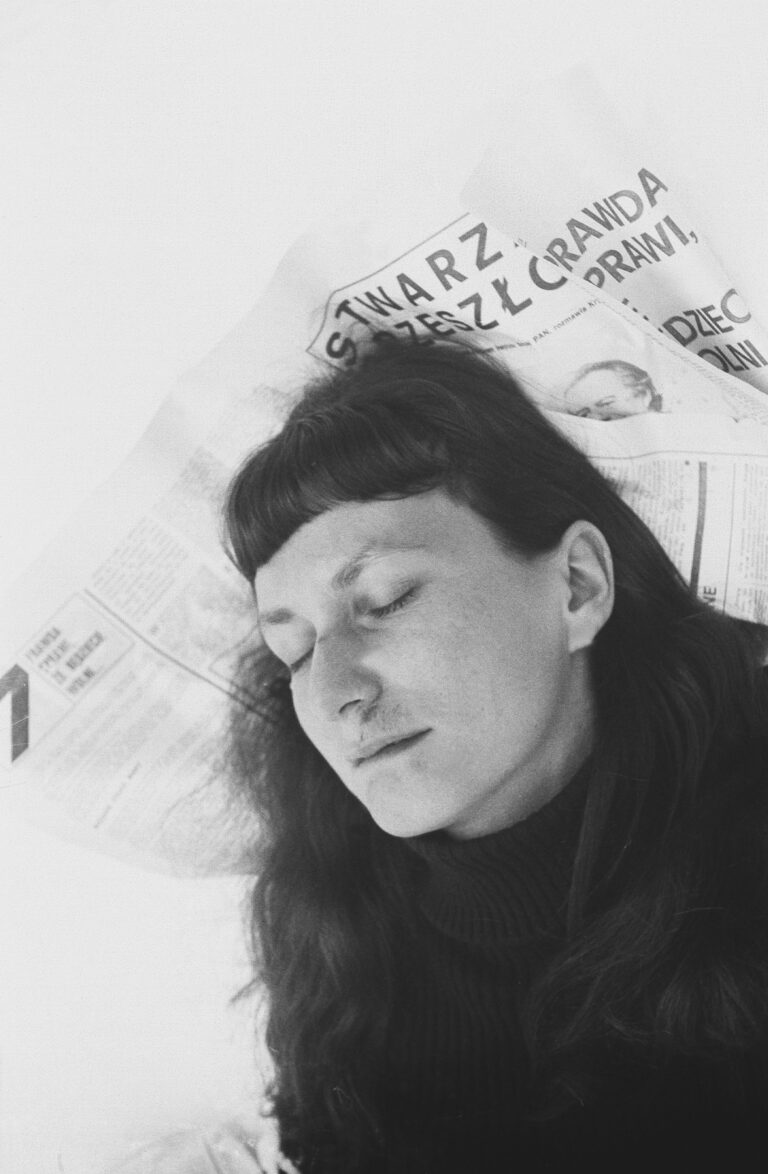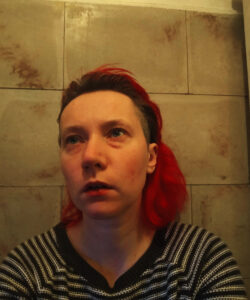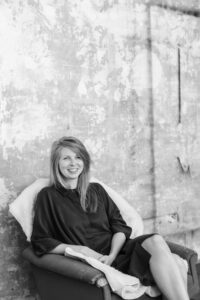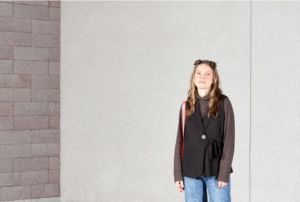Ewa Kuryluk

– born 1946 – an extremely versatile artist working mainly in the medium of painting and photography, art historian and writer. She was one of the pioneers of installation art, which began with a series of ethereal works made on fabrics placed in public spaces. Her works, often touching on the subject of carnality, are largely inspired by autobiographical motifs. Kuryluk developed a characteristic, realistic way of representation, based on synthesis. Internationally known artist today divides her life between Paris and Warsaw.
Statement in key words
War: On 6.08.1945 the atomic bomb fell on Hiroshima. Nine months later, on 5.05.1946, I was born in Krakow as the first child of Karol and Mia Kuryluk. A year later my parents moved to Warsaw, where I became a small archaeologist, archivist and assemblage artist. I gathered scraps dug out from the ruins and newspaper photos of war crimes and arranged them in patterns under the radiator.
Mother: Miriam Kohany (1917-2001), poet, amateur pianist and painting enthusiast. She lost her parents and sister in the Holocaust. After escaping from the Lviv ghetto, she was saved thanks to Karol. He also helped her husband, Teddy Gleich (possibly my biological father). After his death in July 1946, she tried to kill herself, became mentally ill and stayed in hidding for the rest of her life. I discovered my parents’ story gradually after my mother’s death.
Father: Karol Kuryluk (1910-1967), Polish language scholar, social activist, founder of the anti-fascist magazine “Sygnały” [“Signals”] (1933-1939), editor-in-chief of “Odrodzenie” [“Revival”] (1944-1948), Minister of Culture and Ambassador to Austria. Since 2003 Righteous Among the Nations.
Feluni: brother Piotr (1950-2003), Wunderkind, became mentally ill after the sudden death of his father. Protagonist of volume III of the family trilogy. Sub-title: “Apotheosis of the Enigma”1.
Goldi: our beloved hamster and the title of the first volume. Subtitle: “Apotheosis of small Animalism”.
Frascati: our flat on the street of that name and the title of volume II, subtitle “Apotheosis of Topography”. Mum’s asylum with van Gogh reproductions on the walls and the piano of my grandmother Paulina Kohany, unknown to me then, murdered in Treblinka.
Vienna (1959-1964): independence. After eight years of study, I gave up the piano and decided to become a painter and self-photographer2. An affair with a Hungarian refugee, twice my age, a painter and filmmaker, introduced me to the art world, and I met Viennese Actionists.
Warsaw (1964-1970): during entrance exams for the Academy of Fine Arts I overheard: “you will not make a painter out of a woman”. I understood that I would have to continue working alone. In 1966 I met Helmut Kirchner3, a physics student at Cambridge. We became life companions. Visiting him in the summer of 1969, I took with me some of my “Human Landscapes”4. Apocalyptic-erotic grotesques from behind the Iron Curtain intrigued the Woodstock Gallery in London, which showed them in May 1970. I concealed the fact about the exhibition in Poland so that it would not interfere with my graduation. I turned my M.A. thesis supervised by Mieczysław Porębski to “Viennese Apocalypse” (1974), and my Ph.D. dissertation on the grotesque into the book “Salome or about Pleasure” (1976)5. The chapter on Judas was censored out of fear of the Church, which prompted me to write in English the book’s second version, published as “Salome and Judas in the Cave of Sex” (1986) in the US and today used as textbook. However, the book is not translated into Polish6.
Symbolic and Subversive Photorealism (1974-1978): anti-pictorial portraits and self-portraits, often with people’s figures multiplied, were composed from photographic silhouettes in such a way that they might be interpreted as allegories, rebuses, private manifestos7. The picture “The Iks Are Us” (1975), representing a black couple in masks, was painted after two of my photographs, one of Helmut, the other of myself, to show our solidarity with an endangered African tribe8.
Air People (1978-2000): title of my Zachęta – National Gallery Retrospective in 2003 and of my book documenting installations made around the world9. These are large-scale drawings, often erotic, executed on light textiles to be hung in the air, laid on the ground or draped over chairs in order to create rooms of memory, theatres of love and outdoorinstallations. The drawings are evocative of various “true images”, such as shadows, imprints, wounds or scars.
Veronica & Her Cloth (1991)11: the first modern, because atheistic, study of the history, structure and iconography of the “true image”, as the face of Christ on Veronica’s cloth is called. The Veronica legend is based on theknowledge of procreation happening in the female body, but the knowledge is camouflaged.
Kangaroo with Camera (1959-2009): catalogue of some 400 self-photographs12 (out of ca. 5000) published sixty years after Jan Żabiński, director of Warsaw Zoo, had given me the pet name “kangaroo”.
My Yellow Years (2000-2019)13: Old-age archaeology and the title of my catalogue published by Artemis Art Gallery after the Polin Museum had abruptly cancelled my yellow installations retrospective. In that period yellow bands and yellow stars appear, and there are references to Mother’s hallucinations. Alongside the parents with usas children are placed the figures of our grandparents, aunt Hilde and Teddy, made after prewar photographs found in Mum’s old winter boots. In my last yellow installation “Krakow 1946”, my pregnant Mother and I, a baby in a pram, meet with the lovely eighteen-year-old Paulina in a yellow room with a window overlooking the railway station in “that horrible place beginning with T”.
The text was written in collaboration with Anna Kowalska (2020).
1Anna Marchewka, Cudowne dzieci, w: “Dwutygodnik”, 09.2019, see: https://www.dwutygodnik.com/artykul/8445-cudowne-dzieci.html.
2Image: Ewa Kuryluk, First self-photograph with a friend (Ewa on the left), 1959 Misano Mare. Courtesy of the artist.
3Image: Ewa Kuryluk, I stand on my head, self-photograph with Helmut Kirchner, 1978, Stuttgart. Courtesy of the artist.
4Szum Magazine, Ewa Kuryluk at the Wozownia Art Gallery, 2017, [in:] "Szum", see: https://magazynszum.pl/czlekopejzaz-ewy-kuryluk-w-galerii-sztuki-wozownia/.
5Agnieszka Sabor, Jan Strzałka, Sztuka nie jest niewinna [Art Is not Innocent], 2003, [in:] “Tygodnik”, see: http://www.tygodnik.com.pl/numer/279303/kuryluk.html.
6Stanley Weintraub, The Lens of the Grotesque, 1988, [in:] “English Literature in Transition, 1880-1920”, see: https://muse.jhu.edu/article/374099/pdf.
7Ewa Kuryluk, Do not Dream of Love, 2016, solo exhibition, National Museum, Krakow, see: https://mnk.pl/wystawy/nie-snij-o-milosci-kuryluk.
8Image: Ewa Kuryluk, The Iks are Us, 1975. Courtesy of the artist and National Museum Warsaw.
9Zofia Gebhard, O twórczości Ewa Kuryluk [About Ewa Kuryluk’s Practice], 2011, [in:]"Czytelnia sztuki", see: http://czytelniasztuki.openform.pl/wp-content/uploads/2011/10/Zofia_Gebhard.pdf.
10Image: Ewa Kuryluk, Self-photograph with a double self-portrait on a cloth, 1986, Buenos Aires. Courtesy of the artist.
11Bernard McGinn, Not Made by Human Hand, 1991, [in:] “The New York Times”, see: https://www.nytimes.com/1991/08/04/books/not-made-by-human-hand.html.
12Image: Ewa Kuryluk, Mr Kangaroo photographs Ms Kangaroo, 2009, photomontage made of self-photographs, Paris. Courtesy of the artist.
13Agnieszka Drotkiewicz, Ewa Kuryluk: kompas moralny [Ewa Kuryluk: moral compass], 2019, [in:] “Vogue Polska”, see: https://www.vogue.pl/a/ewa-kuryluk-kompas-moralny.
– urodzona w 1946 – niezwykle wszechstronna artystka działająca głównie w medium malarstwa i fotografii, historyczka sztuki oraz pisarka. Była jedną z pionierek sztuki instalacji, którą zapoczątkowała seria eterycznych prac wykonanych na tkaninach umieszczanych w przestrzeniach publicznych. Jej dzieła, często poruszające temat cielesności, w dużej mierze inspirowane są wątkami autobiograficznymi. Kuryluk wykształciła charakterystyczny, realistyczny sposób przedstawiania, opierający się na syntezie. Znana na międzynarodowej arenie twórczyni dziś dzieli swoje życie pomiędzy Paryż i Warszawę.
Statement w kluczowych hasłach
Wojna: 6.08.1945 spadła na Hiroszimę bomba atomowa. W dziewięć miesięcy potem, 5.05.1946, urodziłam się w Krakowie jako pierwsze dziecko Karola i Mii Kuryluków. W rok potem rodzice przeprowadzili się do Warszawy, gdzie zostałam małą archeolożką, archiwistką, asamblażystką. Wykopywane z ruin szpargały i wydzierane z gazet zdjęcia wojennych zbrodni gromadziłam pod kaloryferem i układałam we wzory.
Matka: Miriam Kohany (1917-2001), poetka, amatorka pianistka, miłośniczka malarstwa. W Zagładzie straciła rodziców i siostrę. Po ucieczce z lwowskiego getta ocalała dzięki Karolowi. Pomógł też jej mężowi, Teddy Gleichowi (być może mojemu ojcu biologicznemu). Po jego śmierci w lipcu 1946 próbowała się zabić, zachorowała psychicznie i ukrywała się do końca życia. Historię rodziców odkryłam stopniowo po śmierci mamy.
Ojciec: Karol Kuryluk (1910-1967), polonista, społecznik, założyciel antyfaszystowskiego czasopisma „Sygnały“ (1933-1939), redaktor naczelny „Odrodzenia“ (1944-1948), minister kultury i ambasador w Austrii. Od 2003 Sprawiedliwy wśród Narodów Świata.
Feluni: brat Piotr (1950-2003), Wunderkind, po nagłej śmierci ojca zachorował psychicznie. Protagonista tomu III rodzinnej trylogii. Podtytuł: „apoteoza enigmy“1.
Goldi: nasz ukochany chomik i tytuł pierwszego tomu. Podtytuł: „apoteoza zwierzaczkowatości”.
Frascati: nasze mieszkanie na uliczce o tej nazwie i tytuł tomu II, podtytuł „apoteoza topografii“. Azyl mamy z reprodukcjami van Gogha na ścianach i fortepianem nieznanej mi babci Pauliny Kohany, zamordowanej w Treblince.
Wiedeń (1959-1964): samodzielność. Po ośmiu latach nauki rzuciłam fortepian, postanowiłam zostać malarką i autofotografką2. Romans z dwa razy starszym uchodźcą węgierskim, malarzem i filmowcem, wprowadził mnie w środowisko artystów, poznałam wiedeńskich akcjonistów.
Warszawa (1964-1970): na egzaminie na ASP podsłuchałam: „z baby nie wykrzesasz malarza“. Zrozumiałam, że będę musiała dalej pracować sama. W roku 1966 poznałam Helmuta Kirchnera3, studenta fizyki w Cambridge. Zostaliśmy towarzyszami życia. Odwiedzając go latem 1969, wzięłam ze sobą trochę „Człekopejzaży“4. Apokaliptyczno-erotyczne groteski zza żelaznej kurtyny zaintrygowały londyńską Woodstock Gallery i pokazała je w maju 1970. Wystawę w kraju zataiłam, by mi nie przeszkodziła w uzyskaniu dyplomu. Z magisterium u Mieczysława Porębskiego powstała „Wiedeńska apokalipsa“ (1974), z doktoratu o grotesce „Salome albo o rozkoszy“ (1976)5. Ze strachu przed Kościołem ocenzurowano rozdział o Judaszu, co mnie skłoniło do napisania wersji angielskiej. „Salome and Judas in the Cave of Sex“ (1986) służy dziś za podręcznik, lecz nie u nas6.
Fotorealizm symboliczny i subwersywny (1974-1978): antymalarskie portrety i autoportrety, często zwielokrotnione, komponowałam z fotograficznych sylwetek w taki sposób, że się zamieniały w alegorie, rebusy, prywatne manifesty7. Czarną parę w maskach – „Ikowie to my“ (1975), namalowałam ze zdjęcia Helmuta i autofotografii na znak solidarności z zagrożonym afrykańskim plemieniem8.
Ludzie z powietrza (1978-2000): tytuł retrospektywy w Zachęcie w 2003 i książki z moją własną dokumentacją instalacji, z którymi objechałam pół świata9. Są to rysunki dużego formatu, często erotyczne, na zwiewnych materiałach do powieszenia w powietrzu, ułożenia na ziemi czy udrapowania na krześle. Powstają z nich pokoje pamięci, teatry miłości i instalacje w krajobrazie10. Rysując je sięgałam do tradycji praobrazu: cienia, odcisku, rany, blizny.
Veronica and her cloth (1991): „Weronika i jej chusta“ (1998)11. Pierwsze nowoczesne, bo ateistyczne, studium genezy, struktury i ikonografii „prawdziwego obrazu“, czyli twarzy Chrystusa na chuście Weroniki. Legenda oparta na wiedzy o procesie reprodukcji w kobiecym ciele, ale wiedzę tę jak każda legenda kamuflująca.
Kangór z kamerą (1959-2009): ok. 400 autofotografii12 (z ok. 5000) wydanych w sześćdziesiątą rocznicę mianowania mnie kangurem przez Jana Żabińskiego, dyrektora warszawskiego ZOO.
Moje żółte lata (2000-2019):13 archeologia na starość i tytuł wydanego przez galerię Artemis katalogu instalacji, których retrospektywę w Polin odwołano nagle po latach pracy. Dominuje żółty kolor opasek, gwiazd i halucynacji mamy. Obok rodziców z nami pojawiają się postaci dziadków, cioci Hilde i Teddy’ego, których zdjęcia z lat młodości znalazłam w starych zimowych butach mamy. W ostatniej instalacji, „Kraków 1946“, mama w ciąży ze mną i ja w wózeczku spotykamy się ze śliczną osiemnastoletnią Pauliną w żółtym pokoju z oknem wychodzącym na stacyjkę kolejową w „tym strasznym miejscu na T“.
Tekst powstał we współpracy z Anną Kowalską (2020).
1Anna Marchewka, Cudowne dzieci, w: “Dwutygodnik”, 09.2019, zob. https://www.dwutygodnik.com/artykul/8445-cudowne-dzieci.html.2Zdjęcie: Ewa Kuryluk, Pierwsza autofotografia z koleżanką (Ewa z lewej), 1959, Misano Mare. Dzięki uprzejmości artystki.
3Zdjęcie: Ewa Kuryluk, Autofotografia z Helmutem Kirchnerem, 1978, Stuttgart. Dzięki uprzejmości artystki.
4Redakcja Magazynu Szum, Ewa Kuryluk w Galerii Sztuki Wozownia, 2017, [w:] “Szum”, zob. https://magazynszum.pl/czlekopejzaz-ewy-kuryluk-w-galerii-sztuki-wozownia/.
5Agnieszka Sabor i Jan Strzałka, Sztuka nie jest niewinna, 2003, [w:] “Tygodnik”, zob. http://www.tygodnik.com.pl/numer/279303/kuryluk.html.
6Stanley Weintraub, The Lens of the Grotesque, 1988, [w:]“English Literature in Transition, 1880-1920”, zob. https://muse.jhu.edu/article/374099/pdf.
7Ewa Kuryluk, Nie śnij o miłości, Kuryluk, 2016, wystawa indywidualna, Muzeum Narodowe, Kraków, zob. https://mnk.pl/wystawy/nie-snij-o-milosci-kuryluk.
8Zdjęcie: Ewa Kuryluk, Ikowie to my, 1975, akryl i kolaż na płótnie, 120 x 150 cm, Muzeum Narodowe, Warszawa. Dzięki uprzejmości artystki i MNW.
9Zofia Gebhard, O twórczości Ewy Kuryluk, 2011, [w:] “Czytelnia sztuki“, zob. http://czytelniasztuki.openform.pl/wp-content/uploads/2011/10/Zofia_Gebhard.pdf.
10Zdjęcie: Ewa Kuryluk, Autofotografia z podwójnym autoportretem na chuście, 1986, Buenos Aires. Dzięki uprzejmości artystki.
11Bernard McGinn, Not Made by Human Hand, 1991, [in:] “The New York Times”, see: https://www.nytimes.com/1991/08/04/books/not-made-by-human-hand.html.
12Zdjęcie: Ewa Kuryluk, Pan Kangór fotografuje panią Kangór, 2009, fotomontaż z dwóch autofotografii, Paryż. Dzięki uprzejmości artystki.
13Agnieszka Drotkiewicz, Ewa Kuryluk: kompas moralny, 2019, [w:] “Vogue Polska”, zob. https://www.vogue.pl/a/ewa-kuryluk-kompas-moralny.


